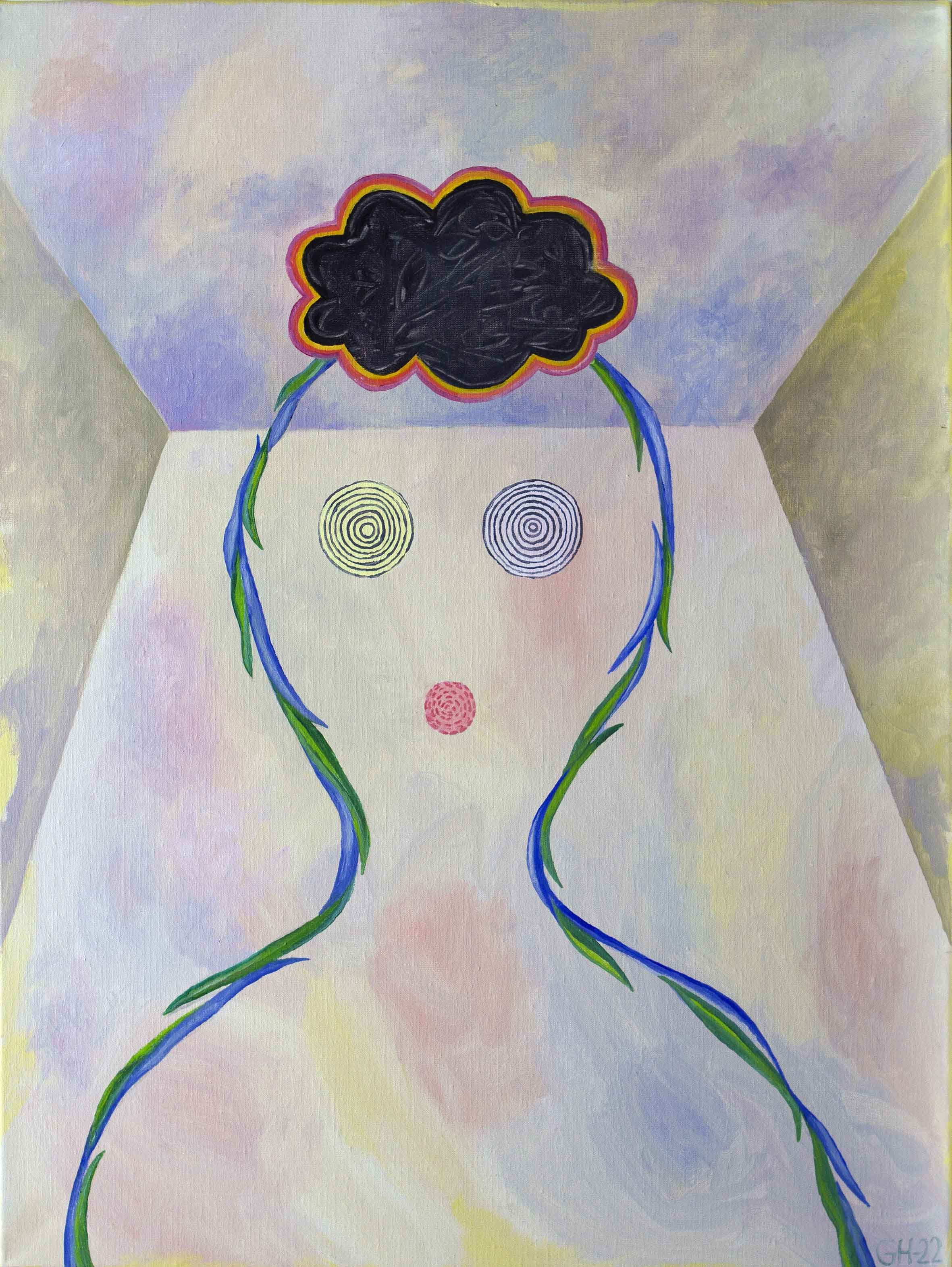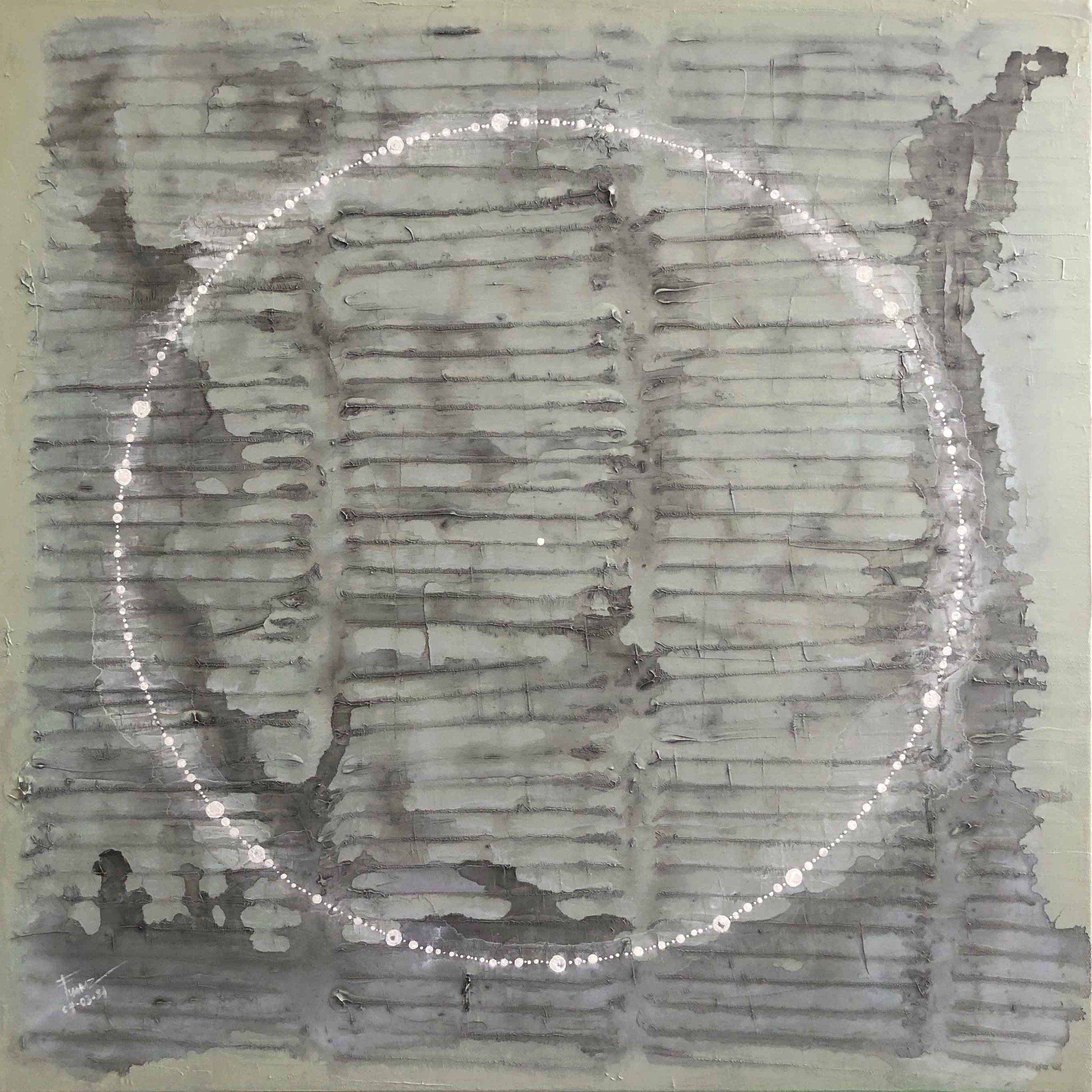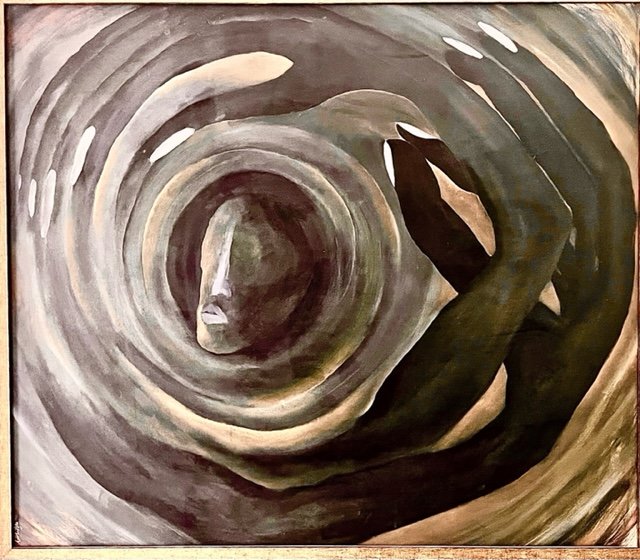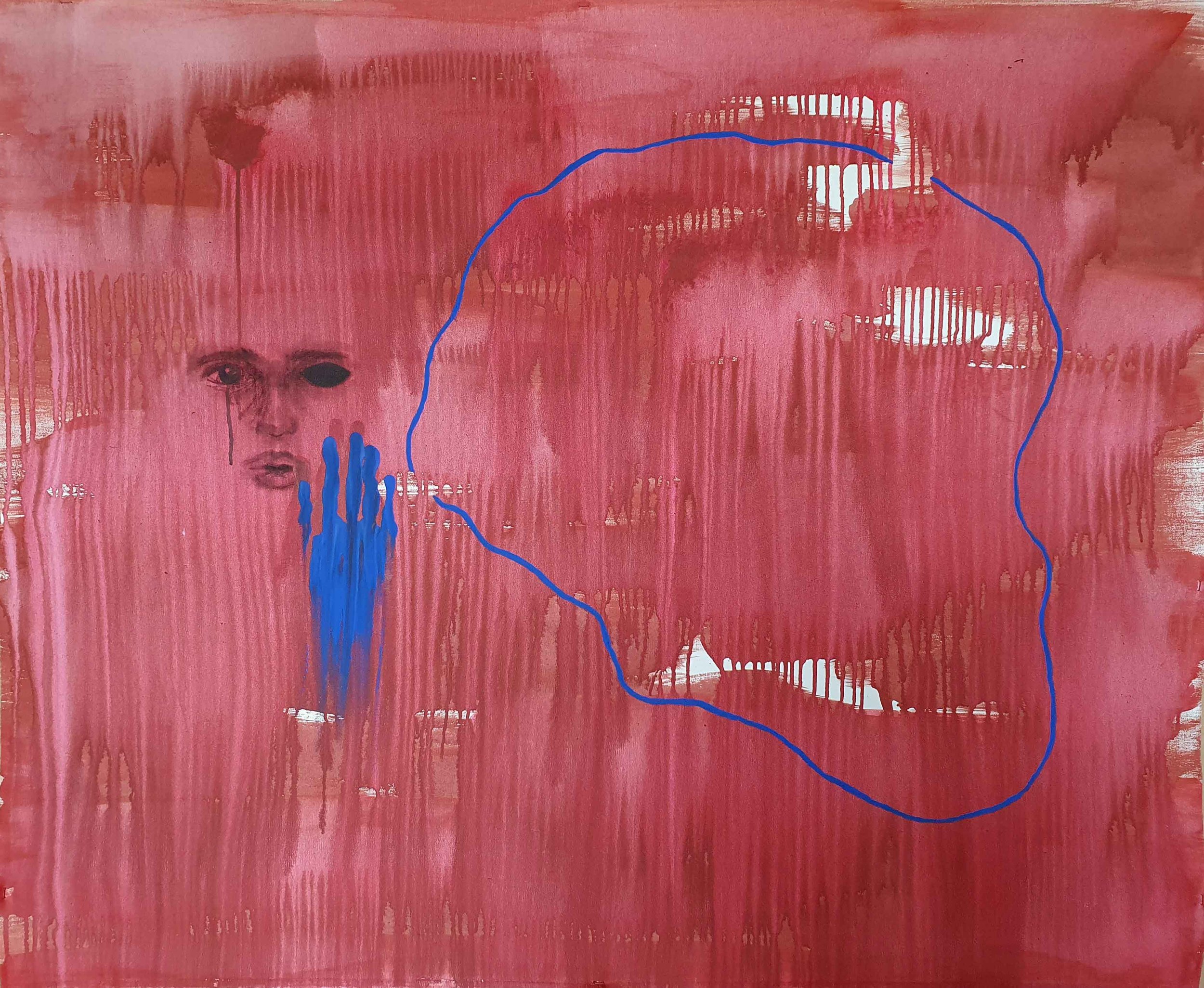
Self-portraits, “self”-portraits and portraits of Self
Featuring works by: Aleksandr Gordeev, Beeli (Bittergod Art), Divya, FC Henry, Gunzi Holmström, Jacq Wang, Kalam Dhari, Kazmier Maslanka, Linda Wright Be In Awe, Long Yinghan, Lucy Mcloughlin, Mariana Monteiro Fernandes, Michael Cu Fua, Oleg Khe, Sudhir Pillai, and T. E. Ang.
Arranged by: T. Shuxia
“Self-portraits are testimonials in which the artist’s ego as his [sic] own model and motif at the same time relates to other people. Artists depict themselves as they want to be seen by others, but also as they want to distinguish themselves from them.”
— Rebel, 2017, p. 7
A self-portrait is perhaps the epitome of an artist presenting to the viewer the presence of themselves. It breaks the fourth wall and reveals that this is them, the person who made their artworks. Like Rebel, I often find self-portraits fascinating. It is a peek into the artist’s lives and psyche. How do they identify themselves and what about themselves would they communicate to others? Here, a great importance is placed on the self and admittedly the self-portrait seems to run contrary to the buddhist concept of emptiness and the illusion of the self.
Why then bring up the subject of self-portraits? One reason is because we have received them in submissions for this journal. There are also works that are self-portrait-like or that carry a message that feels deeply personal. Then, there is the theme for this issue- self and not-self. When I attempt to understand not-self, I inadvertently think about the self. So I thought, why not address the elephant in the room, the SELF?
Self-portraits
As a self-portrait is a representation of the artist, in order to make the art a certain introspection happens in the artist's mind. Who am I, what issues do I care about, what do I like or dislike, what am I good or not good at, what do I want to show or not show my viewers, etc, are examples of what the artist might think about. The concluding outcome of this inquiry could be as simple as looking into the mirror or taking a photograph. On the other end of the scale, it could be an over-complicated self-analysis. And for some artists, this process of making a self-portrait is a gateway to deep-dive reflections and discoveries. I too have sketched a self-portrait more than once, ruminating on who I am; at times lost and angsty, at times proud and hopeful, at times existential. At the risk of over-generalising, I think many of us in the search to understand our lives, at some point were courageous to start with understanding ourselves. With that step of self-awareness taken, we could then continue to venture farther afield. I think that the creation of a self-portrait is a metaphor of that endeavour.
Please click on images for more details of artworks.
The Cloud of Unknowing
Gunzi Holmström (2022)
80 x 60 cm
Oil on canvas
www.gunholmstrom.com
Self Portrait
Divya (2022)
100 x 100 cm
Mixed media on canvas
instagram.com/divya.lotliker
To myself tenderly
Oleg Khe (2022)
2627 x 3183 px
Drawing
artsillustrated.com/oleg-khe-artist
Let me go
Jacq Wang (2021)
76 x 61 cm
Acrylic on canvas
Self Portrait - My Soul
Kalam Dhari (2019)
27.2 x 42 cm
pen and ink drawing
shikhabaheti.com
I am
Michael Cu Fua (2021)
61 x 61 cm
Acrylic, ink, time, and gravity on canvas
cufua.com
“Self”-portraits
Now, to continue exploring the motif of the self-portrait, the most direct proposition would be to attempt a “self”-portrait with buddhism’s notion of “self”. What would that portrait be like?
… … Allow me a few moments to fantasize… …
I imagine that it could either be an unfathomably large piece of artwork, or infinitely small - it will actually be kind of invisible. It could be unfathomably big because the self does not exist independently and is impermanent. Consider what Buddha found when he gained enlightenment,
“After a long time of contemplation, he came to the realization that all form, including our flesh and bones, and all our emotions and all our perceptions, are assembled- they are the product of two or more things coming together. When any two components or more come together, a new phenomenon emerges - nails and wood become table; water and leaves become tea; fear, devotion and a saviour become God. This end product doesn’t have an existence independent of its parts. … Meanwhile the parts have undergone a change. Just by meeting, their character has changed and, together, they have become something else- they are “compounded.”
- Khyentse, 2007, p. 15
So, this “self”-portrait will have images of lots and lots and lots of parts coming together in a long chain of interconnection. They make our physical bodies, our clothes, our living spaces, our experiences, our socio-cultural, political and economic backgrounds, our characters and personalities, our families and friends, our values and beliefs, our emotions, etc. Not only that, because these parts change when they meet or are connected (as is evident in how we age, change our minds, suffer climate change and so on), the “self”-portrait will have to keep updating itself. Perhaps it should be made as a real-time animated film with innumerable screens playing the different connections and changes that are happening at the same time.
There Is a Fire in Me
Gunzi Holmström (2022)
60 x 80 cm
Oil on canvas
www.gunholmstrom.com
Tapestry of Pulsating Droplets
T. E. Ang (2022)
122 x 91 cm
Mixed media on canvas
Impermanence III
Long Yinghan (2004)
90 x 70 cm
Oil on canvas
Our Wounds Our Wisdom
Beeli (Bittergod Art) (2022)
21 x 29.7 cm
Watercolour, letter stamp
https://bittergodart.com/
PJ meditation
Lucy Mcloughlin (2021)
132 x 159 cm
Digital
atlucys.com
This “self”-portrait could also be very tiny because ultimately Buddha taught that all things have no inherent existence. We are put together by interdependent components. In a sense, we are a part of the clockwork of everything but at the same time, when deconstructed and scrutinised, everything dissipates to nothing.
“If we really analyze, as Siddhartha did, we will find that labels such as “form”, “time”, “space”, “direction”, and “size” are easily dismantled. Siddhartha realized that even the self exists only on a relative level, just like a mirage. His realization brought an end to his cycle of expectation, disappointment, and suffering.”
-Khyentse, 2007, p. 57
For this “self”-portrait, we shall thus do the opposite. Instead of finding the connections between parts, we disassemble them, like dismantling a lego sculpture of ourselves. The lego bricks fall away to reveal an emptiness. If there was a core, that too was disassembled.
Now, this is a very strange feeling. Were we not a moment ago, an entity? Despite being connected to everything, we were there. But now we are not. As much as I try to write my way into grasping this, I could not. Seeking an answer, I looked around for clues and saw a ghostly label called “self” floating behind. It is really an apparition in my mind and doesn't exist. It would do me good to ignore it for is there any point to a portrait now? But I am addicted to "self". The more I look at the label, the more it solidifies. I remember all sorts of emotions- the yearning to find my identity, to address my grievances, to prove what I can do. I stubbornly pick it up to complete my portrait. I think to myself, “self”-portraits are stories of how we cling to this insatiable label called “self”.
If you were to make a “self”-portrait, what would it be like?
Loss of self
Sudhir Pillai (2022)
90 x 40 cm
Acrylic on canvas
Emptiness in Form: Me? Diagram I
Long Yinghan (2012)
101.6 x 71.1 cm
Charcoal and ink on paper
Vividly Empty
Linda Wright Be In Awe (2022)
7500 x 7500 px
Procreate - iPad app using liquify
instagram.com/ll.wrightli
Self Conscious - I see you see me
Divya (2022)
100 x 130 cm
Acrylic and charcoal on canvas
instagram.com/divya.lotliker
Hiding from Reality
Lucy Mcloughlin (2021)
132 x 159 cm
Digital
atlucys.com
Portraits of Self
Last but not least, among the artworks submitted to this issue’s theme, I thought there were many self-portrait-like works. They did not identify themselves as self-portraits, though there are images of person(s), silhouette(s), or body part(s) that the viewer might be inclined to think of as a representation of the artist. Many of the works attempt to illustrate what the self is -the self being the concept and not the person. To play on the word ‘portrait' which is defined as “a detailed description of something or someone (The Britannica Dictionary), I decided to term these artworks Portraits of Self.
Here are some renditions of Portraits of Self. For more insights to the artworks, do click on the images to read their artist statements.
10,000 Dharmas Return …
Kazmier Maslanka (2013)
60.96 x 60.96 cm
Digital Art mounted in a backlit frame
kazmaslanka.com
9 bodies
Aleksandr Gordeev (2022)
50 x 50 cm
digital illustration
aleksandrgordeev.com
Discourse on SELF beyond self
T. E. Ang (2019)
180 X 122 cm (Diptych)
Mixed media on canvas
Life Stages
Mariana Monteiro Fernandes (2022)
21 x 28.7 cm
Digital Painting
marianamonteiro.portfoliobox.net
True Self
FC Henry (2022)
21 x 29.7cm
Watercolor on paper
References
Khyentse, D. J. (2007). What makes you not a buddhist. Shambhala Publications.
Rebel, E . (2017). Self-portraits. TASCHEN GmbH.




















